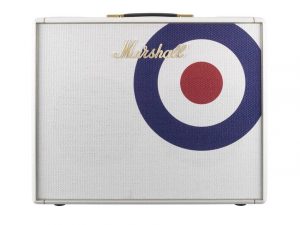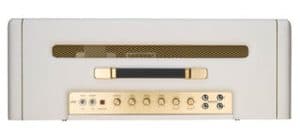Paul Weller’s 50th birthday, Marshall Lead & Bass 50 PW amp, a limited edition of 50. You can’t fool us: there’s a theme developing here. Dave Petersen finds out if Marshall hits the target.
Nobody would argue with Marshall’s choice of Paul Weller as a figurehead for their latest signature amp – for musical credibility. And long-term achievement there’s perhaps no one more suitable who’s still regularly performing. He’s also inspired Marshall’s graphics guys to surpass themselves. The big roundel emblem so firmly tied to mid-’60s mod culture is used to great effect on the pristine white finish, while the rear panel joins in with an etched picture of the Modfather, signed by himself and Dr Jim. No doubt about the visuals, then, particularly if you’re a Weller fan or a born-again mod. But what’s the 1987X-PW like as an amp?

This is a reissue model 2100 Lead & Bass 50, originally made only from 1973 to 1976, and the last shout for the two-channel model 1987 metal-panel chassis. It has some voicing differences from standard 1987’s, with an extended low-frequency passband in Ch 2 and a modified Ch 1 with, theoretically, slightly more lower mids than the extremely trebly 1987 Super Lead. The result – a 1987 head in a Bluesbreaker cab.
Pros and Cons Marshall Lead & Bass 50 PW
Table of Contents
It has the best materials and workmanship: 18mm birch ply throughout, with a perfectly applied heavy-grade cover and speaker cloth. It’s fitted with a pair of Celestion G12Cs, an uprated version of the G12M that would have been found in the original 2100, also used to good effect in VM Series cabs and combos. Purists may frown, but our memory of G12Ms in older Marshall combos was that they were pretty marginal in their handling of the fierce output of the 50W head. Originally intended to drive four of them in a half-stack, so this is a reasonable change.

Internally, the chassis has an almost tactile aura of extra care. From the seamless corner welding of the chassis to the perfectly routed and dressed wiring from the main board to the hardwired valveholders, pots and jacks. Welcome additions are to be found in the form of a hum-balance pot for the heater line, bias-current measuring resistors in the output stage (it’s a nuisance having to fit these to carry out a standard service). And extra screening for the wires to and from the volume pots, which could pick up buzz at working settings in the older chassis. Component quality is beyond reproach – carbon film resistors and high-quality coupling caps everywhere. Connected to big, smooth-action pots and ceramic valveholders, and switches and selectors are as good or better than the originals.
Sounds Marshall Lead & Bass 50 PW
Old Marshalls had a slight hum when switched on, even before warming up. It’s pleasing to note that’s a thing of the past. There’s not a whisper from the Marshall Lead & Bass 50 PW until the standby’s switched on. Confirming that some useful work’s been done in the earthing and routing department. Channel 2 Volume and all tones at half gives huge gig levels with a Strat, fully justifying the ‘Bass’ part of the amp’s name. It needs backing off to around 3/10 to be sensible. The tone stack is classic Marshall, gentle at small-room levels but more emphatic as you approach stage levels. The tone is ultimate Brit, big and warm with a just-perceptible U-curve.

Repatching to Channel 1 is a different story, because even a very low Volume setting gives a loud, slicing tone. This may be a revised 1987, but all the old Super Lead fire and aggression is still there. Remembering that the Ch 1 volume pot is heavily treble-bypassed helps. Because by turning it to halfway with the guitar wound down we get a more reasonable contour. With a small noise penalty. The guitar can then be maxed for solos, giving the Weller signature – armour-piercing crunch. Clarity and a volume that will outgun the competition, handled capably by the G12C speakers.
Channels
A more useful sound is available by coupling the two channels, with the Bass channel dominant. The spread of tone is stunning and calms the excesses of the Lead channel on its own. Our SG takes us yet further down the Weller road. With high-register sustain and cut-through underpinned by big, warm bass. Strongly recalling his ’70s Ricky/Marshall stack sound. It’s easy to understand why this is his weapon of choice these days. With the humbuckers snarling and clanging beautifully. Even if it was difficult to prevent ours from whistling happily to themselves between phrases. This is a gigging amp, no mistake, and its natural environment is the rock stage.
Verdict
The Marshall Lead & Bass 50 PW is based on an amp that grew up before PAs and noise-limiters and had to make its point in crowded clubs against loud competition. And it represents all that’s great about British amp building, with uncompromising tone and volume. It has a sound that might survive being used with a speaker attenuator. Iin fact, you could well need one to comply with today’s health and safety conditions. On the understanding that a big part of the asking price of this amp goes to a good cause. And given its unique sound, visual impact and build quality, your sense of value for money will be satisfied – if you can find one, that is.

Leave a Reply
You must be logged in to post a comment.